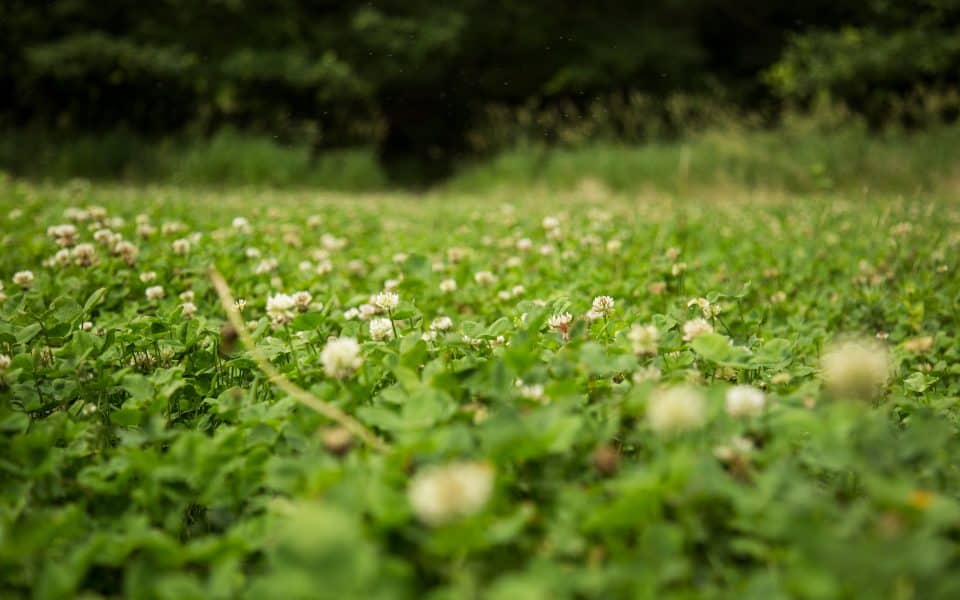The Lucky Legume: A “four-leaf clover” is a rare variation of the normal three-leaf version – and you’ve probably heard about the luck that is supposed to accompany them. I don’t know about all the superstitious mumbo-jumbo, but I do know clovers don’t need four-leaves to provide you and your wildlife with loads of benefits. Many consider a successful clover food plots to be the “cornerstone” of their food plot program. Different varieties are chosen for various characteristics to meet specific management goals, growing conditions, or management styles – regardless, perennial clovers should be in your program.
If you manage ground for whitetails, you probably have some clover planted. Four decades ago, it was the number one thing planted specifically for whitetails, especially if you live in our mid-tier states or to the north. Those in the South may also plant clovers, but the cooler, humid growing season in the North favors these legumes. Whether your goal is attraction or nutrition, a perennial clover blend should be on your “menu” because of the wide range of benefits to whitetails and numerous other wildlife species.
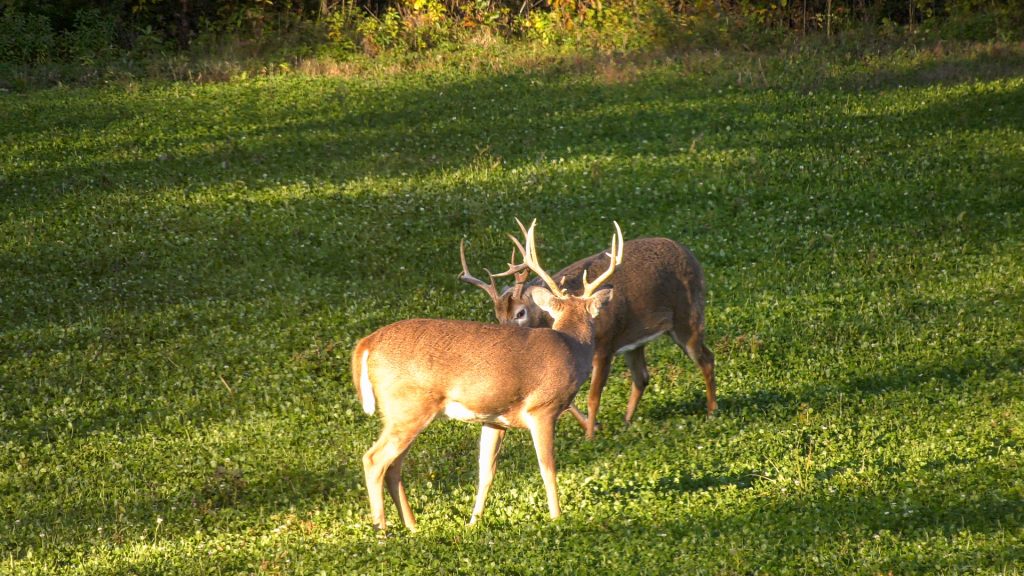
Drury Outdoors
Perennial clovers are a green, high-quality source of nutrition in the spring when the deer are coming out of their most tough time of the year. These perennials will be available to wildlife before any annual crops are planted and will often be obtainable even before many native foods begin to emerge. Pending growing conditions, it should continue to remain a great food source through the summer and into fall until winter dormancy.
White clovers can provide years of quality, high protein, extremely attractive forage. Red clovers tend to be a bit easier to grow in a wider range of conditions; however, they are typically not as attractive to whitetails as most white varieties. The best products for most gamekeepers will be a “blend” of several different clover varieties and possibly other perennials like alfalfa, trefoils or chicory. With a blend, you not only supply your herd a wider array of choices and attractive options for longer than a single variety, but you also protect yourself against failure due to specific growing conditions unfavorable to certain cultivars.
When maintained properly and planted in soil that is initially close to a neutral pH (6.3 to 7.0), perennial clover blends can produce for six to eight years or more. In more acidic soils, because of the need to incorporate more lime when the soil reverts back to being too acidic, depending on your soil type and original pH you can expect more like three to five years from your crop and then you’ll need to incorporate lime again. It would also be a good idea to rotate in a different crop for a growing season before you plant clovers again in the same soil. I’ve had clover plots that produced well for ten to twelve years.
When managed correctly, white clovers will spread by sending out stolons (a stem that grows horizontally along the ground surface). The stolon will create nodes (a joint on a plant stem where a leaf attaches) where roots will form. This process creates “daughter plants” which will replace the initial seedlings within a few years. Perseverance tends to be highest in the varieties that create the most stolons, which is typically the small-leaf white clovers.
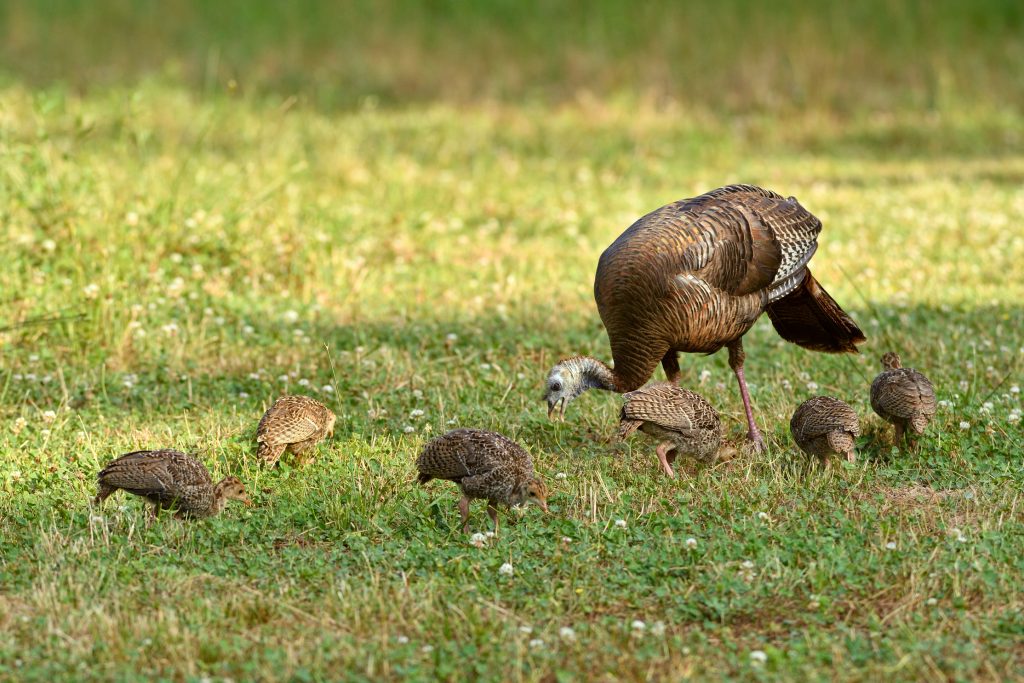
Tes Jolly
Renewal from seed is also possible. If the plants are not browsed heavily or mowed often, they will flower and produce seed. Regeneration from seed helps longevity in areas with dry summer conditions.
Large-leaved clover types perform best when mowed less frequently, or when browsing pressure is limited and plants are allowed to mature. On the other hand, the small-leaved types respond better to frequent browsing and/or mowing. Large-leaved varieties grow taller and stand upright more than the small-leaved types. Small-leaved varieties typically have thick stolons and strong roots. Large-leaved types have fewer stolons and typically do not regenerate or persist quite as long as medium and small-leaved white clovers. Because of the large stolons, they are also more likely to be detached by browse pressure.
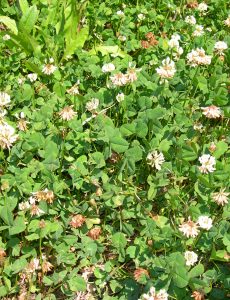
Todd Amenrud
The small-leaved types tolerate constant browse pressure best. As said, small-leaved types do not grow as tall as the larger-leaved clovers, but they have numerous small leaves and many stolons. These characteristics make it an excellent choice for areas that receive heavy browse pressure.
As you may have guessed, medium-leaved types are intermediate in features. These perform well under a wider range of situations and a good addition to most blends.
Given the different management necessities of the numerous varieties, before choosing which types of clover to plant, think about your growing conditions, your deer density in relation to the amount of acreage you will provide in clover, and how often you will be able to mow it. As an example, if you don’t have the resources to mow the plot frequently, especially during the spring when clover grows rapidly, or if the deer density is low in relation to the amount of quality forage available, then a large-leaved form would be preferable. Again, for most, a blend of different types will be the best selection and the growing/management conditions will bring the favorable cultivars to the forefront. The yield of most white clover types (large-leaved to small-leaved) is similar if each type is managed properly.
If you have the resources to mow the stand frequently during the spring and/or the deer density is high relative to the capacity to produce quality forage, then a small-leaved type of clover would be preferable. These types of clover perform best when the stolons are exposed to sunlight – which encourages daughter plant production at the nodes. This response ensures the stand is thick (many plants per square foot) and new plants are being constantly produced to ensure the stand remains productive for many years.
I suggest that your total perennial acreage be planted in stages so that it is not all the same age. If you replant, that it means the field will probably not provide prolifically until its second year. Ground preparation and planting, combined with waiting for germination, root development and the time required to produce enough growth for feeding deer requires so much time that it is equivalent to “cleaning the table” and asking your “guests” to dine somewhere else. By planting in stages, you never need to eliminate all of your perennials at once.
A characteristic that does vary is how long the stand will persist and the quantity of high-quality forage produced. Deer prefer clover leaves over stems because the quality of the stem is much less than the leaf. Although hungry deer will browse clover to the ground, stems and all, we don’t want our deer that hungry.
The Correct Soil Fertility and pH for Clover
Soil pH has a profound effect on the availability of nutrients to plants and microorganisms. The basic macronutrients of calcium, magnesium, sodium and potassium are found only in low amounts in acid soils (low pH) and are most readily available in neutral or alkaline soils. Micronutrients, iron, copper, manganese and zinc are highly soluble and readily taken up by the plant at low pH, but in acidic soils some of these nutrients can be present at levels toxic to clovers.
Legumes are particularly sensitive to acid soils, mainly related to the legume-rhizobia relationship. Another factor is the increase in the availability of metal cations such as aluminum and manganese when there is a low pH. Therefore, although white clover is tolerant of acidic soils, and will grow in soils with a pH as low as 5.3, they perform much better in soils with a pH of 6.5 to 7.0. White Clover will not perform in alkaline or saline soils, as it requires high soil phosphate levels for maximum production.
White clover is well adapted to environments ranging from moderately to extremely high fertility, but is poorly adapted to low fertility soils. To maximize white clover growth and nitrogen fixation in low fertility soils, large amounts of phosphate fertilizer is usually required along with enough lime to balance the pH. In addition, sulphur and potassium are usually applied. Phosphorus is an important nutrient for the development of a vigorous root system, and a phosphorus deficiency may affect the plants uptake of other nutrients.
White clover can use nitrogen from two sources, atmospheric fixed nitrogen from their root nodules and mineral nitrogen from synthetic sources. If available, mineral nitrogen should be used only when establishing the crop. However, too much mineral nitrogen fertilizer will inevitably lead to a decreased white clover content in plant species mixtures. To put it simply, if you give clover nitrogen, you train your clovers to be lazy and they begin to fail to produce enough on their own. To ensure proper soil conditions a soil test is highly recommended.
Environment Effects on Clover
White clover stops growing when temperatures drop to approximately 46 to 48 degrees Fahrenheit, and reaches its maximum growth rate at 77 degrees Fahrenheit. The winter growth of white clover cultivars varies, but is relatively low depending on location (obviously due to cold temperatures). The main growth period of white clover is during spring and summer, although droughts greatly influence growth. White clover can survive short-term drought by losing its leaves and then re-growing from stolons after the soil moisture improves, but survival is poor when the annual rainfall is less than 25-inches. In the case of poor rainfall, annual or biannual varieties can often still be used and planted to coincide with rain events.
Rainfall is the major environmental determinant of white clover performance. Even where rainfall is considered adequate, summer/autumn dry periods can still result in large-scale loss of white clover. Once soil moisture dips below the wilting point in hot weather, clover leaves die, wither and disappear quickly, leaving stolons and the soil’s surface exposed to sunlight. Once available soil moisture is used up, stolons overheat, collapse and die quickly. This often happens in the South. In the North, our clovers enter dormancy for the winter, but in the South, dormancy can occur during the hot, dry summer months and then may resume growth throughout the winter months.
Seasonal Clover Production and Management
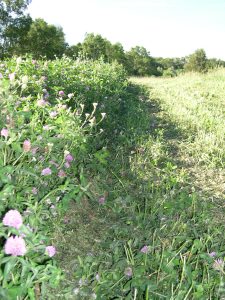
Todd Amenrud
During winter, (where the ground isn’t frozen), more than 90% of stolons can be buried by treading and earthworm activity, with new stolons establishing on the soil surface during spring and summer. However, during spring, white clover plant populations are fragile and susceptible to stress. At this time, stolon death exceeds formation of new stolons as larger plants break up into many smaller plants. In addition, the energy from photosynthesis is redirected from stolon branch development into root system and leaf development. This means we see large leaves develop on the plants if not mowed. Some believe this to be a “good thing.” Yet, not mowing the plots can be damaging. Not mowing as frequently does allow the development of larger plant leaves, however, it also has a negative effect on the structure of plants in terms of decreasing the number of leaves, stolons, and roots produced. Simply stated, when not mowed periodically, the stand will not be as productive or healthy in the future. Seeing large leaves on the clover disguises the fact that more frequent mowing would actually produce more yield and insure better plant community health and future production.
The frequency and intensity of mowing can markedly influence the plant population. Frequent defoliation during spring favors white clover growth and stolon development as this allows light to penetrate the base of the white clover, which in turn, encourages stolon development. Low browse pressure has the same effect. Less browse pressure on white clover plots, in combination with less frequent mowing, leads to less defoliation and less production of new stolons, stems and leaves.
Besides the frequency of mowing, another aspect of clover maintenance is how much of the plant height should be removed during mowing. The interaction between mowing frequency and severity has a significant effect on the size of individual plant organs (leaf area, internode length and diameter). Infrequent, severe defoliation usually caused by infrequent mowing during the spring will allow development of larger organs (leaves, tillers etc.). However, this results in the death or disappearance of new growth. More frequent mowing, but not removing as much of the plant each time will restrict total plant height, but enhances tiller and stolon survival and increases the stem density per acre.
Increasing the frequency of mowing decreases the time available for full expression of leaf area, reducing overall leaf size. However, the plant density and total tonnage of leaves produced increases. In addition, frequent mowing helps control most weeds and ensures new, succulent growth is available – which wildlife prefer over mature leaves.
It’s important to note that this pattern of frequent mowing to improve plant community vigor is reversed in the summer. Once soil moisture levels decrease towards the summer months, overgrazing or mowing is detrimental to plant community health, as frequent mowing produces an excessive loss of stolons. In hot or dry conditions, white clovers should not be mowed frequently, and should even be left unmowed long enough to produce seed heads.
Reproduction Propagation
The importance of legume persistence through reproduction (produce seeds) is clear for annual legumes. There is evidence to show that in many cases, natural reseeding is necessary to re-establish populations of perennial white clover after drought-induced collapses. Annuals avoid the dry period by existing as seed and re-establish in the autumn when adequate soil moisture levels are restored, and their reproductive path to reestablishment is clear.
With perennial clovers, stand persistence can be promoted both by frequent mowing during the spring to increase stolon production and survival, and no mowing during droughts or when the clover is growing slow to promote seed production.
The Best Varieties of Clover
After all this discussion about different types of clover and management techniques, what varieties are best? Clover Plus is my go-to blend. I like to mix it with Non-Typical and plant it at 9-lbs per acre. Clover Plus contains a mixture of tall, medium and short growing white clovers. With this mixture, the plant variety that performs best in each specific plot location will eventually come to the forefront in the stand – Nature’s way of handing competition – the best adapted species eventually dominates. In addition to the different varieties of white clover, perennial red clovers and chicory are included. These red clovers and chicory perform better in the warmer, drier conditions of summer.
Caring for Clover Food Plots
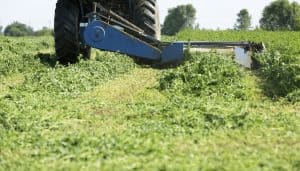
oticki
Mow your clover several times throughout the season. Mowing helps to cut down on broadleaf weeds and unwanted grasses and it promotes new, more palatable growth on your clover and chicory. I mow my fields at least four times during the growing season.
Choosing the proper fertilizer for clover is also important – a blend with no nitrogen is recommended. Without knowing the results of a soil test, usually about 250 pounds of 0-20-20 per acre will work well. Legumes produce their own nitrogen, if you add nitrogen to legumes you encourage other grasses and unwanted weeds to take root and you train your clover to be lazy and stop affixing its own.
If you have grass problems, I suggest treating with an herbicide with the chemical clethodim about 10 days after mowing the field, or in the springtime, usually when the daytime highs are in the 70’s, but before the grass reaches 8-10 inches tall. Clethodim is a grass-specific (only kills grass) herbicide. Other grass-specific herbicides will also work.
Where needed, every other spring I also overseed with more Clover Plus at a rate of about ¼ of what I would do if I were initially seeding the plot. This helps fill in gopher mounds, wheel ruts and bare spots and adds new young seedlings to the plot.
Clover is not a “magic bean” and it’s not the best option for every food plot site. However, it will grow in a wide-variety of locations. Established stands of clover produce quality forage when it is still too cold to plant spring crops. It’s also frequently the last green crop during the fall. Although I’ve presented a somewhat complicated description of why white clovers need to be maintained in a specific pattern, white clover care is not that complicated. Mow it frequently when conditions are conducive to rapid growth, and during hot and/or dry weather, do not mow as frequently, or at all. White clover stands are most beneficial to wildlife when they persist for many years and provide forage without requiring the manager to “clean the food plot table” and re-establish the plot.

